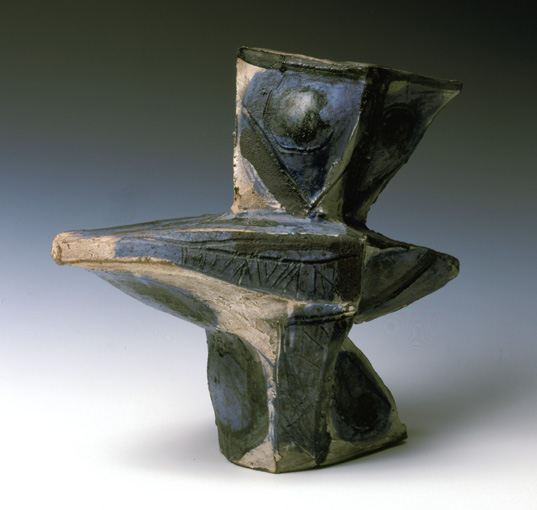
Peter Voulkos
Bird Vase, 1958
Stoneware, glazed
9 x 15 x 15 in.
Gift of Mr. and Mrs. Fred Marer
Scripps College, Claremont, CA
Peter Voulkos is regarded as one of the most important ceramists of the 20th century. His career reshaped the role of ceramics, pushing it into the arena of fine arts. After mastering traditional ceramic conventions, an accomplishment that is no small feat, he rejected its rules and the strict utilitarian function of ceramics that had kept the art form in the craft realm. Instead, Voulkos began to use clay to make expressive sculpture.
Born to a Greek immigrant family in Montana in 1924, Voulkos’ creative career began after his service in the Air Force during the Second World War. There he served as an aircraft nose gunner. This position required him to operate the machine gun at the “nose” of an aircraft. Like many other members of the armed forces, his experience of witnessing and participating in combat may have led him to question traditional values, including the commitment to maintaining the functionality of ceramics. The violence of his wartime experiences also may have influenced techniques Voulkos employed in his work: gashing holes, abrading the surface, and making asymmetrical vessels.
With the support of the G.I. Bill, Voulkos studied at Montana State College, where he received a bachelor’s degree in applied arts in 1951. He then relocated to California to further his education and earned a master’s of fine arts at the California College of Arts and Crafts. Voulkos was quickly regarded as a master of ceramics, gaining recognition for his technique, and winning nearly thirty awards in a six-year span, from 1949 to 1955.
His skill level was so advanced that almost immediately after his education was complete, in 1953, he was invited to instruct a summer session at Black Mountain College. There, Voulkos was exposed to a progressive approach to learning that included the arts as a significant element in learning and rejected the traditional intellectual hierarchy of educational institutions. This institution’s values may have influenced Voulkos’ nontraditional approach to ceramics in his work.
The Black Mountain College model also could also have influenced his teaching style, which he demonstrated the following year, when he began instructing at LA County Art Institute, now called the Otis College of Art and Design. As a teacher, Voulkos viewed his students as creative peers, rather than pupils. It was also here, in mid-fifties southern California, where Voulkos started to test the boundaries of ceramics by abstracting the forms without regard for preserving functionality or maintaining the traditional ceramic aesthetic model. Peter Voulkos constantly experimented and challenged the boundaries of ceramic sculpture. His work increasingly became free-form and improvisational. This approach would characterize the work of a career that spanned across five decades.
An example of Peter Voulkos’ expressive and geometric work would include Bird Vase (1958). The work depicts an abstracted head of a large bird. The piece is glazed in black and varying shades of blue, dressing the whimsically placed incisions found throughout the piece. Some incisions add to creating a bird-like quality, defining the bill and eyes, but some are purely decorative. The piece first forces the viewer’s eye to the massive bill of the bird. The attention is then focused on the large eyes of the bird on either side of the top portion of the head. The asymmetry of this form creates a gestural quality; it is as if the bird were in motion, moving forward. There are three distinct sections of this piece, the top, containing the eyes, the mid-section, characterizing the bill, and the bottom, representing the neck of the bird. These distinct sections reflect Voulkos’ tendency to piece layers together while the clay was in its leather-hard phase一 another technique atypical of traditional ceramic practices. Bird Vase perfectly demonstrates the expressive and nontraditional ceramic methods that made Peter Voulkos a significant pioneer in the ceramic medium.
Hannah Avalos, Getty Multicultural Intern 2018, Fullerton College ’19
Photo by Susan Einstein
Bibliography
“About the Museum.” Black Mountain College Museum + Arts Center, www.blackmountaincollege.org/about/.
Clarke, Chris. “The Cannons on the B-29 Bomber Were a Mid-Century Engineering Masterpiece.” Popular Mechanics, Popular Mechanics, 14 Nov. 2017, www.popularmechanics.com/military/weapons/a18343/the-cannons-on-the-b-29-bomber-were-a-mid-century-engineering-masterpiece/.
Harvey, Lucy. “The Ceramicist Who Punched His Pots.” Smithsonian.com, Smithsonian Institution, 19 Apr. 2017, www.smithsonianmag.com/smithsonian-institution/ceramicist-who-punched-his-pots-180962930/.
MacNaughton, Mary Davis., et al. Clay’s Tectonic Shift, 1956-1968: John Mason, Ken Price, Peter Voulkos. J. Paul Getty Museum, 2012.
Peter Voulkos- (1924-2002). ASU Art Museum, May 2008, asuartmuseum.asu.edu/sites/default/files/voulkos_peter_biography.pdf.
“Peter Voulkos: On Improvisation.” Frank Lloyds Blog, 9 July 2009, franklloydgallery.wordpress.com/2009/07/09/peter-voulkos-on-improvisation/.
Pierce, Robert. “WWII Veteran Talks about Being a B-24 Nose Gunner.” Deseret News, 3 June 2011, https://www.deseretnews.com/article/700141303/WWII-veteran-talks-about-being-a-B-24-nose-gunner.html.
Smith, Roberta. “Peter Voulkos, 78, a Master Of Expressive Ceramics, Dies.” The New York Times, The New York Times, 21 Feb. 2002, www.nytimes.com/2002/02/21/arts/peter-voulkos-78-a-master-of-expressive-ceramics-dies.html.

